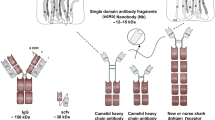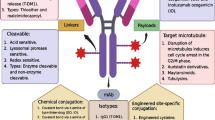Abstract
Urokinase-targeted recombinant bacterial protein toxins are a sort of rationally designed and engineered anticancer recombinant fusion proteins representing a novel class of agents for cancer therapy. Bacterial protein toxins have long been known as the primary virulence factor(s) for a variety of pathogenic bacteria and are the most powerful human poisons. On the other hand, it has been well documented that urokinase-type plasminogen activator (uPA) and urokinase plasminogen activator receptor (uPAR), making up the uPA system, are over-expressed in a variety of human tumors and tumor cell lines. The expression of uPA system is highly correlated with tumor invasion and metastasis. To exploit these characteristics in the design of tumor cell-selective cytotoxins, two prominent bacterial protein toxins, i.e., the diphtheria toxin and anthrax toxin are deliberately engineered through placing a sequence targeted specifically by the uPA system to form anticancer recombinant fusion proteins. These uPA system-targeted bacterial protein toxins are activated selectively on the surface of uPA system-expressing tumor cells, thereby killing these cells. This article provides a review on the latest progress in the exploitation of these recombinant fusion proteins as potent tumoricidal agents. It is perceptible that the strategies for cancer therapy are being innovated by this novel therapeutic approach.
Similar content being viewed by others
References
Abi-Habib R J, Liu S H, Bugge T H, Leppla S H, Frankel A E (2004). A urokinase-activated recombinant diphtheria toxin targeting the granulocyte-macrophage colony-stimulating factor receptor is selectively cytotoxic to human acute myeloid leukemia blasts. Blood, 104: 2143–2148
Abi-Habib R J, Singh R, Liu S, Bugge TH, Leppla SH, Frankel A E (2006). A urokinase-activated recombinant anthrax toxin is selectively cytotoxic to many human tumor cell types. Mol Cancer Ther, 5: 2556–2562
Arora N, Leppla S H (1993). Residues 1–254 of anthrax toxin lethal factor are sufficient to cause cellular uptake of fused polypeptides. J Biol Chem, 268: 3334–3341
Choong P F, Nadesapillai A P (2003). Urokinase plasminogen activator system: a multifunctional role in tumor progression and metastasis. Clin Orthop Relat Res, 415(Suppl): S46–58
Duffy MJ (2004). The urokinase plasminogen activator system: role in malignancy. Curr Pharm Design, 10: 39–49
Duffy M J, Duggan C (2004). The urokinase plasminogen activator system: a rich source of tumour markers for the individualized management of patients with cancer. Clinical Biochemistry, 37: 541–548 Special Issue: Recent Advances in Cancer Biomarkers
Ehrlich P (1956). The relationship existing between chemical constitution, distribution, and pharmacologic action. In: Himmelweite F, Marquardt M, Dale H, ed. The Collected Papers of Paul Ehrlich, 1. London: Pergamon Press, 596–618
FitzGerald D J, Kreitman R, Wilson W, Squires D, Pastan I (2004). Recombinant immunotoxins for treating cancer. Int J Med Microbiol, 293: 577–582
Frankel A E, Beran M, Hogge D E, Powell B L, Thorburn A, Chen Y Q, Vallera D A (2002). Malignant progenitors from patients with CD87+ acute myelogenous leukemia are sensitive to a diphtheria toxin-urokinase fusion protein. Exp Hematol, 30: 1316–1323
Frankel A E, Rossi P, Kuzel T M, Foss F (2002). Diphtheria fusion protein therapy of chemoresistant malignancies. Curr Cancer Drug Targets, 2: 19–36
Holmes R K (2000). Biology and molecular epidemiology of diphtheria toxin and the tox gene. J Infect Dis, 181 Suppl 1: S156–167
Klimpel K R, Molloy S S, Thomas G, Leppla S H (1992). Anthrax toxin protective antigen is activated by a cell surface protease with the sequence specificity and catalytic properties of furin. Proc Natl Acad Sci USA, 89: 10277–10281
Liu S, Aaronson H, Mitola D J, Leppla S H, Bugge T H (2003). Potent antitumor activity of a urokinase-activated engineered anthrax toxin. Proc Natl Acad Sci U S A, 100: 657–662
Liu S, Bugge TH, Leppla SH (2001). Targeting of tumor cells by cell surface urokinase plasminogen activator-dependent anthrax toxin. J Biol Chem, 276: 17976–17984
Liu S, Redeye V, Kuremsky J G, Kuhnen M, Molinolo A, Bugge T H, Leppla S H (2005). Intermolecular complementation achieves high-specificity tumor targeting by anthrax toxin. Nat Biotechnol, 23: 725–730
Liu S, Schubert R L, Bugge T H, Leppla S H (2003). Anthrax toxin: structures, functions and tumour targeting. Expert Opin Biol Ther, 3: 843–853
Mogridge J, Cunningham K, Collier R J (2002). Stoichiometry of anthrax toxin complexes. Biochemistry, 41: 1079–1082
Moolten F L, Capparell N J, Zajdel S H, Cooperband S R (1975). Antitumor Effects of Antibody-Diphtheria Toxin Conjugates. II. Immunotherapy with Conjugates Directed against Tumor Antigens Induced by Simian Virus 40. J Natl Cancer Inst, 55: 473–477
Ramage J G, Vallera DA, Black J H, Aplan P D, Kees U R, Frankel A E (2003). The diphtheria toxin/urokinase fusion protein (DTAT) is selectively toxic to CD87 expressing leukemic cells. Leuk Res, 27: 79–84
Rønø B, Rømer J, Liu S, Bugge T H, Leppla S H, Kristjansen P E (2006). Antitumor efficacy of a urokinase activation-dependent anthrax toxin. Mol Cancer Ther, 5: 89–96
Rustamzadeh E, Hall W A, Todhunter D A, Vallera V D, Low W C, Liu H, Panoskaltsis-Mortari A, Vallera D A (2006). Intracranial therapy of glioblastoma with the fusion protein DTAT in immunodeficient mice. Int J Cancer, 120: 411–419
Rustamzadeh E, Vallera D A, Todhunter D A, Low W C, Panoskaltsis-Mortari A, Hall W A (2006). Immunotoxin pharmacokinetics: a comparison of the anti-glioblastoma bi-specific fusion protein (DTAT13) to DTAT and DTIL13. J Neurooncol, 77: 257–266
Schlessinger D, Schaechter M (1993). Bacterial toxins. In: Schaechter M, Medoff G, Eisenstein BI, editors. Mechanisms of microbial disease. 2nd ed.Baltimore: Williams and Wilkins, 162–175
Su Y, Ortiz J, Liu S, Bugge T H, Singh R, Leppla S H, Frankel A E (2007). Systematic urokinase-activated anthrax toxin therapy produces regressions of subcutaneous human non-small cell lung tumor in athymic nude mice. Cancer Res, 67: 3329–3336
Todar K (2008a). Bacterial Protein Toxins. In: Todar’s Online Textbook of Bacteriology (http://www.textbookofbacteriology.net/proteintoxins.html)
Todar K (2008b). Diphtheria. In: Todar’s Online Textbook of Bacteriology (http://www.textbookofbacteriology.net/diphtheria.html)
Todar K (2008c). Pseudomonas aeruginosa. In: Todar’s Online Textbook of Bacteriology (http://www.textbookofbacteriology.net/pseudomonas.html)
Todar K (2008d). Bacillus anthracis and anthrax. In: Todar’s Online Textbook of Bacteriology (http://www.textbookofbacteriology.net/Anthrax.html)
Todhunter D A, Hall W A, Rustamzadeh E, Shu Y, Doumbia S O, Vallera D A (2004). A bispecific immunotoxin (DTAT13) targeting human IL-13 receptor (IL-13R) and urokinase-type plasminogen activator receptor (uPAR) in a mouse xenograft model. Protein Eng Des Sel, 17: 157–164
Vallera D A, Li C, Jin N, Panoskaltsis-Mortari A, Hall W A (2002). Targeting urokinase-type plasminogen activator receptor on human glioblastoma tumors with diphtheria toxin fusion protein DTAT. J Natl Cancer Inst, 94: 597–606
Author information
Authors and Affiliations
Corresponding author
Rights and permissions
About this article
Cite this article
Liu, Y., Li, SY. Urokinase-targeted recombinant bacterial protein toxins — a rationally designed and engineered anticancer agent for cancer therapy. Front. Biol. China 4, 1–6 (2009). https://doi.org/10.1007/s11515-008-0074-2
Received:
Accepted:
Published:
Issue Date:
DOI: https://doi.org/10.1007/s11515-008-0074-2




